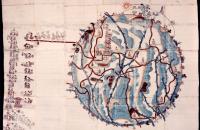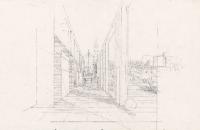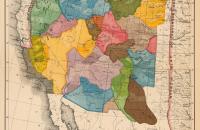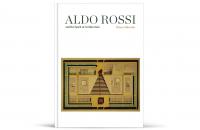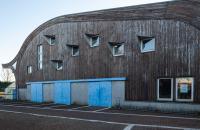Professor in Residence, Department of Architecture, GSD, Harvard University, Cambridge MA, USA
Issue's articles
In This Issue [1/2020]
VOLUME 5/2020 - Issue 1 , Pages: 5 - 7 published: 2020-06-24Wellbeing in the Built Environment: Designing Discontinuities Between Function and Semantic
VOLUME 5/2020 - Issue 1 , Pages: 31 - 52 published: 2020-05-21Space is relational. How many relationships can occupy a space? How do they work? These are both interesting questions that we would like to answer. We know that we interact with space and that its configuration affects us: we can be aggregative while experiencing it, rather than competitive. Space has considerable power in influencing our brain. Essentially, our actions are somehow manipulated by what we see and what we touch. How does our space (peripersonal space) interfere with another’s? The idea of interaction within space (or social space) and space of selfhood thus becomes an essential subject for architecture and cannot be simply parameterized in a geometric manner. Physical space must, therefore, allow solitary or cooperative movement without alienating the individual. We base our judgments on movement, culture, personal psychical characteristics, memory, and personal experience. Taking these elements as our base, we gave a new perspective for designers to draw from the semantic, which can be rhetorical and disconnected by the function.
We are All Counterinsurgents Now
VOLUME 5/2020 - Issue 1 , Pages: 53 - 70 published: 2020-06-24The increasing production of robust, information-laden, parametric architectural and urban models has outpaced a critical evaluation of the ethics of contemporary modeling and visualization practices which, rather than reflecting reality, are transforming it. This essay exposes the logics of the expropriation of architectural and urban models in a decade-old RAND Corporation endeavor to envision a comprehensive digital counterinsurgency strategy. To encourage professional and cultural agents, as well as unwitting civilian agents, to populate databases with urban and environmental data, RAND proposed weaponizing open-source, big-data urban models and participatory platforms to create multicultural, user-friendly interfaces. Conceived to appear like an exercise in open-source digital democracy and participatory knowledge-sharing that would spark emotive responses such as pride and fear, RAND focused on the cognitive and affective side of digital participation and information sharing to wage a counterinsurgency in the minds of civilians and insurgents. When the models that architects build can be weaponized to ends other than realizing buildings and cities, when they become instruments for influencing behavior and facilitating warfare, there is an urgent need for an ethics of visualization.
American Mirror: the Occupation of the ‘New World’ and the Rise of Architecture as We Know It
VOLUME 5/2020 - Issue 1 , Pages: 71 - 88 published: 2020-05-18This paper argues that the rise of architecture as a unique discipline and the conquest of the American continent are not just chronological coincidences but interdependent variables of the same process of modernization. Traditional scholarship in architecture has not entertained those parallel developments at all. The field of architectural history and theory still treats the spatial occupation of the Americas as a consequence of the Renaissance and European modernization, despite a few decades of scholarly literature in related disciplines questioning such assumptions. (Fanon 1961; Said 1978; Dussel 1980; Bhabha 1987; Escobar 1994). Such scholarship demonstrates that the encounter of 1492 and the territorial occupation that followed played a central role in the development of Western culture in general, allowing the extrapolation of the same logic to the architectural discipline in particular.
On the CIAM 7 Grid: From an Ideological to a Critical Tool
VOLUME 5/2020 - Issue 1 , Pages: 89 - 117 published: 2020-05-21Much historiographical research has been produced on the post-war CIAMs, demonstrating the importance of the CIAM Grid, proposed as a “thinking tool” for representing the town planning projects at the CIAM 7 in Bergamo (1949). This essay proposes a new critical and epistemological examination of the CIAM Grid based on new archival documents and on a rereading of the exact words used by Le Corbusier, who proposed to consider the Grid as an “interlocutor.” Seventy years later, we propose to go beyond the failure of CIAM 7 and to elaborate a “new Grid,” with the name of “Second Life Grid,” as a critical tool for discussing exclusively projects related to the new paradigm of recycling and reusing buildings and urban spaces. Beginning with the question of the critical legacy of the CIAM Grid, our intention was to think of a Grid conceived no longer as an instrument of dogmatic and normative thought, but as an instrument of dialogical criticism which has been tested through an open call for projects and an international conference held in Bergamo in October, 2019.
Musings on Boredom, Midcentury Architecture, and Public Spaces
VOLUME 5/2020 - Issue 1 , Pages: 119 - 138 published: 2020-06-11The rejection of “boredom” fueled the midcentury reaction against modernism, but little is known about the complicated presence of this mood in the architectural discourse. Far from being a mere rhetorical tool, the quip “Less is a bore” is part of Robert Venturi’s larger interest in boredom and was influenced by his reading of a book referenced repeatedly in Complexity and Contradiction in Architecture (1966): August Heckscher’s The Public Happiness (1962). A liberal writer and political activist, Heckscher situated boredom at the core of modern humanity’s alienation. While the concern with boredom was explicitly addressed in the humanities, I suggest that it was taking shape in midcentury architectural polemics under the influence of writings from other disciplines, as well as the emerging artistic practices that were deliberately embracing the “aesthetics of boredom.” Specifically, I will examine Venturi’s reading of Heckscher through two of his (unbuilt) civic projects that directly engage the issue of boredom: Three Buildings for a Town in Ohio (1965) and the entry for the Copley Square Competition (1966).
A Lab for a New Civitas. An Innovative School in the Po Valley
VOLUME 5/2020 - Issue 1 , Pages: 139 - 162 published: 2020-06-17Sorbolo is a beautiful town located halfway between the ancient ducal city of Parma and the Po River, within a countryside that developed from marshes, rows of poplars, embankments, vineyards. In 2016, after an initial planning process, the municipality of Sorbolo submitted to the MIUR (Ministero dell’Istruzione, dell’Università, e della Ricerca) a plan for the development of a school campus. The facility was meant to be open to the local territory and community, parents, and citizens wishing to have a stake in the decision-making processes that apply to the education and training of young people.
The first step was the construction of a new building complex destined to a 24 hour school system, accomodating approximately 450 students, ten to fourteen years old, supported by a cross-disciplinary approach: “a school for everyone, motivational, open, innovative.” The firm UFFICIO PROGETTI Architetti Associati Bertani & Vezzali, with the Sorbolo project, was the second winner of the MIUR international contest for the creation of 52 innovative schools over the entire Italian territory.
Waving the Magic Wand: An Argument for Reorganizing the Aridlands around Watersheds
VOLUME 5/2020 - Issue 1 , Pages: 163 - 184 published: 2020-05-21Irrigation remains the primary means of sustaining urbanization and stabilizing agricultural productivity in arid America. In the contest for the West, water is both wealth and power. Today’s struggle to overturn water scarcity is traceable through a long history of legislation overseeing land regulation, property speculation, societal development, and cultural attitudes, real and perceived, inscribed within the America’s aridlands. In reality, there is no magic wand - no miraculous technology - that alone will fulfill the needs of all who have been promised abundance in the aridlands. This paper proposes that revisiting John Wesley Powell’s 1893 proposal for aridland development in the context of today’s ecological conditions catalyzes an alternative response to today’s predictions of changing climates, and can provide the basis of an approach to the aridlands which builds from the enmeshed relationship between social and environmental systems.
Landscape Lifecycles as a Speculative Design Research Practice for Transforming Waste Conditions
VOLUME 5/2020 - Issue 1 , Pages: 185 - 220 published: 2020-06-23Research-based design has been foundational for landscape architecture. Analytical layering in geographically-based mappings has become a universally applied, formulaic approach. For waste landscapes, this has generated similar redevelopment strategies for drastically differing waste landscape conditions. This site typology, however, requires more nuanced approaches. As a design-research framework, “landscape lifecycles” aims to tackle waste landscapes with integrative strategies and techniques that reactivate waste as a legible and dynamic contributor to local and regional contexts; a method for integrating multiple diverse programs rooted in economic, environmental, and social performance to form hybrid assemblages in the transformation of perceived material and spatial waste. This article highlights design-research and generative representational methods developed through projects and coursework that embrace speculation as a means of engaging with waste conditions at multiple scales — from the material to the region. These methods range from speculative geographic, process, and abstract mapping to scenario testing to time-based, projective design that document, explore, and test an argumentative hypothesis and the multi-scalar design implications of research on the imaginative potentials of waste transformation.
Disaster Planning Across Scales: Lessons from Post-Earthquake Rubble Management in Oaxaca, Mexico
VOLUME 5/2020 - Issue 1 , Pages: 221 - 250 published: 2020-06-10This paper examines rubble management as an important but often neglected component of disaster response and a powerful example of the frequent disconnect between national plans and local action. It focuses on five marginalized municipalities in Oaxaca, Mexico: Ciudad Ixtepec, Asuncion Ixtaltepec, El Espinal, Juchitan de Zaragoza, and Santa Maria Xadani. These constitute the region most affected by the Mexican earthquakes of September 2017, with roughly 58% of inhabitants suffering either partial or total loss of their houses. The paper builds on the results of fifty-one interviews, a cross-sectional survey with 384 residents, and a mapping analysis to reveal the challenges of post-disaster planning across scales. The results show that local perspectives were given little consideration in nationally-led rubble management plans, and that these documents were likely shaped by concerns over what constituted institutional legitimacy, rather than attention to local context. The paper concludes with a discussion of the findings through the lens of institutional isomorphism and offers recommendations for more effective post-disaster rubble management, particularly centered on increasing the involvement and capacity of residents, municipal governments, and other key institutions.
Aldo Rossi: Representing Life
VOLUME 5/2020 - Issue 1 , Pages: 253 - 259 published: 2020-05-11
Aldo Rossi and the Spirit of Architecture
By Diane Y. F. Ghirardo
London: Yale University Press
254 mm x 203 mm
135 color + 5 b/w illustrations
280 pages
US$65 / £50.00 GBP (hardback)
ISBN: 978-0300234930
Giancarlo De Carlo. A Symposium
VOLUME 5/2020 - Issue 1 , Pages: 261 - 278 published: 2020-05-11Architectural Portraits: ῾The MIES Project’
VOLUME 5/2020 - Issue 1 , Pages: 9 - 30 published: 2020-05-14This article wants to offer a brief overview of my experience as an architectural photographer and of “The Mies Project” in particular, on which I have been working on for the past few years. My approach to photography, based on the latest digital technology but also on the Leica M-System, is briefly outlined. In the past, the question was how to obtain information. Nowadays, the proper structuring of information is what really matters. Architectural Portraits, a small selection of which from “The Mies Project” are here presented, are “intimate gazes,” prioritizing the relationship of the detail of a building with its surrounding, the interaction between construction details, lighting and weather conditions. In this sense, Mies’ works not only have sparked my interest in architectural photography, but have been also the perfect poetic partner for my research.



